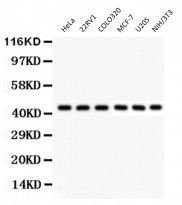ARG59681
anti-KIN / Kin17 antibody
anti-KIN / Kin17 antibody for Western blot and Human,Mouse
Overview
| Product Description | Rabbit Polyclonal antibody recognizes KIN / Kin17 |
|---|---|
| Tested Reactivity | Hu, Ms |
| Tested Application | WB |
| Host | Rabbit |
| Clonality | Polyclonal |
| Isotype | IgG |
| Target Name | KIN / Kin17 |
| Antigen Species | Human |
| Immunogen | Recombinant protein corresponding to K3-K202 of Human KIN. |
| Conjugation | Un-conjugated |
| Alternate Names | DNA/RNA-binding protein KIN17; KIN, antigenic determinant of recA protein homolog; Rts2; KIN17; Binding to curved DNA; BTCD |
Application Instructions
| Application Suggestion |
|
||||
|---|---|---|---|---|---|
| Application Note | * The dilutions indicate recommended starting dilutions and the optimal dilutions or concentrations should be determined by the scientist. |
Properties
| Form | Liquid |
|---|---|
| Purification | Affinity purification with immunogen. |
| Buffer | 0.9% NaCl, 0.2% Na2HPO4, 0.05% Sodium azide and 5% BSA. |
| Preservative | 0.05% Sodium azide |
| Stabilizer | 5% BSA |
| Concentration | 0.5 mg/ml |
| Storage Instruction | For continuous use, store undiluted antibody at 2-8°C for up to a week. For long-term storage, aliquot and store at -20°C or below. Storage in frost free freezers is not recommended. Avoid repeated freeze/thaw cycles. Suggest spin the vial prior to opening. The antibody solution should be gently mixed before use. |
| Note | For laboratory research only, not for drug, diagnostic or other use. |
Bioinformation
| Database Links | |
|---|---|
| Gene Symbol | KIN |
| Gene Full Name | Kin17 DNA and RNA binding protein |
| Background | The protein encoded by this gene is a nuclear protein that forms intranuclear foci during proliferation and is redistributed in the nucleoplasm during the cell cycle. Short-wave ultraviolet light provokes the relocalization of the protein, suggesting its participation in the cellular response to DNA damage. Originally selected based on protein-binding with RecA antibodies, the mouse protein presents a limited similarity with a functional domain of the bacterial RecA protein, a characteristic shared by this human ortholog. Alternative splicing of this gene results in multiple transcript variants. [provided by RefSeq, Jan 2012] |
| Function | Involved in DNA replication and the cellular response to DNA damage. May participate in DNA replication factories and create a bridge between DNA replication and repair mediated by high molecular weight complexes. May play a role in illegitimate recombination and regulation of gene expression. May participate in mRNA processing. Binds, in vitro, to double-stranded DNA. Also shown to bind preferentially to curved DNA in vitro and in vivo (By similarity). Binds via its C-terminal domain to RNA in vitro. [UniProt] |
| Cellular Localization | Nucleus. Cytoplasm. Note=During S phase, strongly associated with the nuclear matrix, and to chromosomal DNA in the presence of DNA damage. Also shows cytoplasmic localization in elongated spermatids. [UniProt] |
| Calculated MW | 45 kDa |
Images (1) Click the Picture to Zoom In






